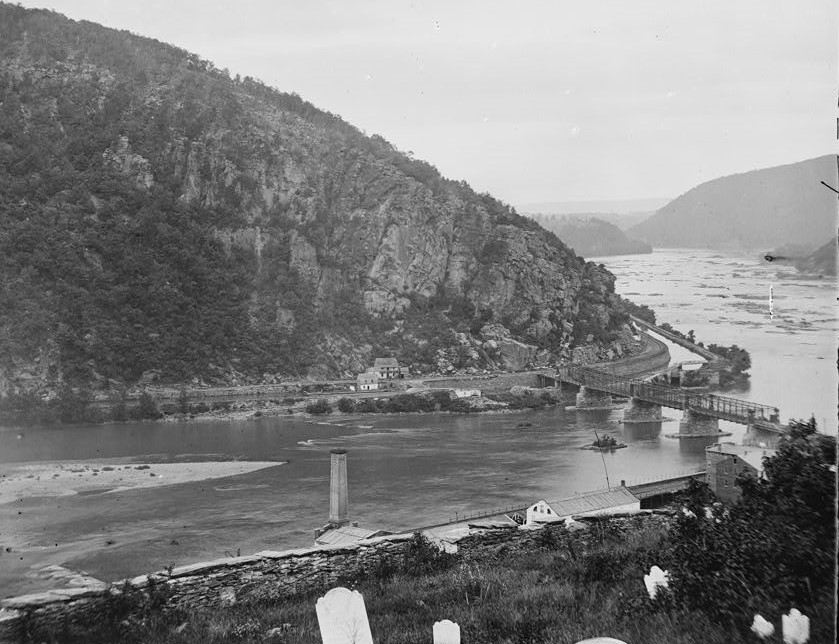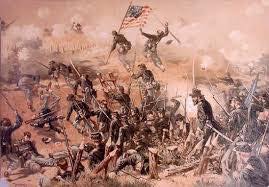From Antietam to Vicksburg: Ohio Soldiers Crossing Civil War’s Great Divide
ECW welcomes guest author Devan Sommerville.
1863 was a year of grand ambitions and even greater logistical feats. The Federal and Confederate war departments, pursuing bold strategic outcomes, authorized dramatic transfers of personnel between the Eastern and Western theaters of war. Entire brigades, divisions, and corps found themselves traveling unfamiliar roads and rivers, re-shuffling the experience of the war.
Yet before these major movements, a pair of Ohio regiments followed solitary paths from the banks of the Potomac to the loamy hills above the Mississippi. In doing so, they bore the distinction of being deeply involved in two of the Civil War’s iconic struggles: the 1862 Maryland campaign and the 1863 siege of Vicksburg.
The 30th and 32nd Ohio Infantry regiments were both organized in response to President Abraham Lincoln’s inaugural call for 300,000 volunteers in 1861. Recruited from towns and farms throughout the northern and eastern parts of the state, both regiments were drawn into the cat-and-mouse struggle in western Virginia, skirmishing in the hollows of the Appalachian and Blue Ridge mountains.
It was during the Maryland Campaign that these regiments were thrust into the moves and countermoves leading to America’s bloodiest day. The 30th Ohio was one of six Ohio regiments that collectively formed the Kanawha Division, a scratch division appended to the IX Corps. The regiment suffered 80 casualties at Antietam, fighting a desperate delaying action against the late-day counterattack of A.P. Hill’s Confederates.

The 32nd Ohio’s involvement was less glorious. Despite a spirited defense of Maryland Heights, it was captured as part of the Federal garrison at Harper’s Ferry. Their colonel, former Ohio lieutenant governor Thomas H. Ford, was cashiered from the service for neglect of duty.
Each regiment’s path to Vicksburg was unique. William T. Sherman took a great interest in the composition of the units under his command, with his XV Corps a veritable retinue of hand-picked regiments and officers.
Surviving correspondence shows Sherman was not above pestering superiors to secure a preferred unit.[1] One target of Sherman’s persistence was his foster brother, Brig. Gen. Hugh Ewing, the 30th Ohio’s original colonel and brigade commander. Sherman engineered an interdepartmental transfer, bringing Ewing and his brigade—including the 30th—into the XV Corps fold in January 1863.[2]
The change in theater was welcomed. “General satisfaction pervaded among the troops,” recounted Henry Brinkerhoff, the regimental adjutant and earliest historian of the 30th Ohio, “and the officers congratulated each other and drank fraternally at the bars of the boat to the fall of Vicksburg.”[3]
The 32nd Ohio’s path to the Army of the Tennessee saw less fanfare. Reorganized after its parole in January 1863, the 32nd journeyed to join Grant’s army near Memphis. It was assigned to the XVII Corps division of Maj. Gen. John “Black Jack” Logan, a hard-fighting Illinois Democrat. Brigaded alongside veteran Illinois regiments and the pugnacious “Irish 7th” Missouri, the Ohio regiment’s prior record wasn’t forgotten. “They welcomed us with the pet name of ‘Harper’s Ferry Cowards,’” recalled Charles Black, a veteran. “Muscle and not bullets settled the story of our cowardice,” he said, with the regimental historian noting many an offender wore “a decorated eye or a sore head.”[4]
Each regiment endured the torments of the long Vicksburg Campaign. By late May, both found themselves facing the city’s landward fortifications. Eager to avoid a prolonged siege and seize the strategic river port through an ambitious assault, Grant prepared to test the city’s sprawling line of forts and rifle pits on the early morning of May 22, 1863. A hurried assault by Sherman’s Corps three days prior was bloodily repulsed. Now Grant upped the ante: a simultaneous assault by three corps, striking along the four main roads and rail lines that pierced the city’s defensive cordon. Each was protected by major fortifications commanding the approaches. The 30th and 32nd were each assigned a pivotal task in reducing two of these bastions: the Stockade Redan and the Great Redoubt.

The Stockade Redan, with a stockade of hewn logs obstructing Graveyard Road, was an imposing salient. Sherman’s earlier May 19 assault had failed, and now his plan was to slice through with massed force along the narrow road. His foster brother, Ewing, drew the unenviable assignment of leading the assault.
He formed a storming party of 150 picked volunteers under two officers from the 30th Ohio: Capt. John H. Groce and Lt. George O’Neal.[5] Sherman, aware of the grim nature of this assignment, later surmised that the detail “might be called a forlorn hope.”[6] Not all were volunteers by choice. Sergeant Andrew Saumauch of the 30th Ohio later recalled, “Not being on very friendly terms,” with his commander, “I took it for granted that it was his opportunity to get revenge on me.”[7]
With the storming party in the lead, carrying Ewing’s flag and scaling equipment, the 30th Ohio was the first regiment in line behind them. Minutes after 10 o’clock, the entire formation surged forward. Confederate fire was withering. Although what Maj. Gen William T. Sherman styled a “forlorn hope” reached the base of the redan, the ladders were too short.[8] The 30th Ohio suffered severely and was pinned down. T.H. Preston, of the color company, described the scene while sheltering in the dusty roadbed: “The road from there to the fort was literally covered with dead and wounded.”[9] The 30th Ohio was unable to withdraw until relieved late that afternoon; the storming party remained trapped until nightfall.[10]

To the south, the 32nd Ohio faced the Great Redoubt. It was in the second line of John D. Stevenson’s brigade, behind the 8th Illinois. Formed in a ravine 200 yards west of the Redoubt, the brigade advanced under “volley after volley” of fire. Reaching a sheltered point, Stevenson ordered the left wing—8th Illinois and 32nd Ohio—to act as reserve while the right wing pressed forward. Despite bravery, the parapet could not be scaled, with the green flag of the 7th Missouri marking the furthest advance.[11]
The toll was significant. The 30th Ohio reported 51 casualties, including six killed, though this understated the blow: “There was not a commissioned officer left in the right wing of the regiment—nothing above a corporal in command.”[12] Captain Groce of the storming party was shot through the arm – “a terrible hole…very painful, keeping me awake all the time,” and Lt. O’Neal was shot three times.[13] The 32nd Ohio lost 23, all wounded.[14]
Both Ohio regiments continued to serve with distinction through the war’s end, remaining with their respective corps as Sherman’s armies advanced through Tennessee, Georgia, and the Carolinas until final victory in 1865. From Antietam’s blood-soaked fields to the smoking bluffs of Vicksburg, the 30th and 32nd Ohio carved out legacies far from home—proof that the war’s reach was as wide as the nation it sought to save.
Devan Sommerville is a consultant lobbyist based in his native Canada, living in Toronto, Ontario with his wife and young son. A lifelong student of the American Civil War and American Antebellum History, he holds an Honours Bachelor of Arts in History and a Master’s in Public Policy from the University of Toronto.
Endnotes:
[1] Ulysses Grant McAlexander. History of the Thirteenth Regiment, United States Infantry (Regimental Press, Thirteenth Infantry, Frank D. Gunn, 1905), 22.
[2] Eric Michael Burke. Soldiers from Experience: the Forging of Sherman’s Fifteenth Army Corps 1862-1863 (Baton Rouge: Louisiana State University Press, 2023), 112.
[3] Henry R. Brinkerhoff. History of the Thirtieth Regiment Ohio Volunteer Infantry, From its Organization to the Fall of Vicksburg, Miss. (Columbus, OH: James W. Osgood Printers, 1863), 66.
[4] Charles W. Black, “Harper’s Ferry Cowards. A Comrade of the 32nd Ohio Vindicates His Regiment,” National Tribune, October 23, 1884; E.Z. Hays, History of the Thirty-second Regiment Ohio Veteran Volunteer Infantry (Columbus, OH: Cott & Evans Printers, 1896), 44.
[5] The War of the Rebellion: The Official Records of the Union and Confederate Armies, Series 1, Vol. 24, Part 2, 282.
[6] William T. Sherman. Memoirs of General William T. Sherman (New York: D. Appleton & Company, 1889), Vol. 1, 354.
[7] Andrew Schamuch, “Storming the Fort. The 30th Ohio Led the Charge, and Bully Jack Climbed Up and Placed the Headquarters’ Flag,” National Tribune, February 2, 1911.
[8] William T. Sherman. Memoirs of General William T. Sherman, Volume 1. (New York: D. Appleton & Company, 1889), 354.
[9] Thomas H. Preston, “Incidents at Vicksburg,” National Tribune, March 31, 1898.
[10] Schamuch, February 2, 1911.
[11] OR, Series 1, Vol. 24, Part 1, 719.
[12] OR, Series 1, Vol. 24, Part 2, 163; Preston. March 31, 1898.
[13] John Groce to Bentley and Matilda Groce, May 28, 1863, printed in Charles G. Will, “Captain John H. Groce,” Pickaway County Historical Society, Pickaway Quarterly, June 1962, 3-6; OR, Series 1, Vol. 24, Part 2, 282.
[14] Ibid, 164.
Nice
Great post.